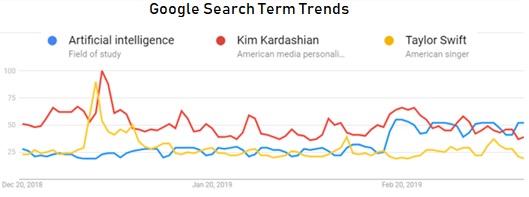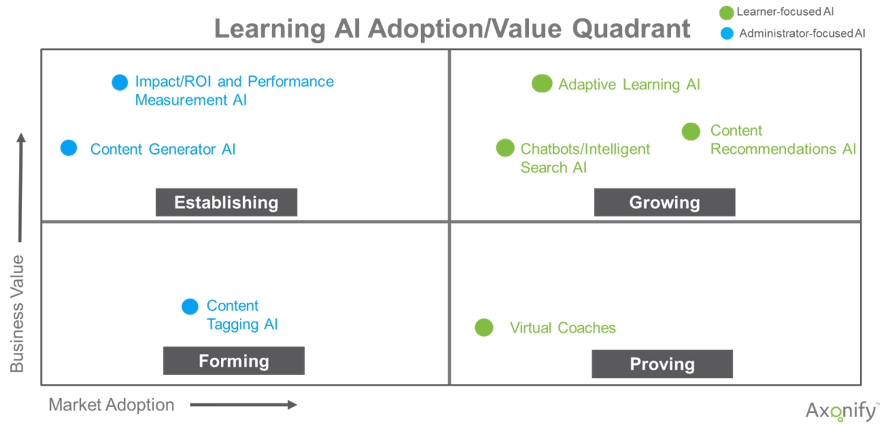It seems like the entire world has been hit with “AI-fever.” Not all that surprising considering that by 2030 it’s expected that AI will provide a $15.7 trillion (US) boost to GDP worldwide. To put that figure into perspective, that’s roughly 13X Australia’s GDP. In fact, AI is such a hot term that Google reports more interest in the term “Artificial Intelligence” than in celebrities like Kim Kardashian and Taylor Swift!

There’s no question that AI is a complicated subject, based in computer science and data. Some people are leaping to applications like smart assistants and bots rather than taking a step back to understand the fundamentals. Many are wondering if AI is something they need to care about. It’s a meaty and exciting topic, so I’m going to boil down some essentials in a 3-minute read that will hopefully leave you with a sense of confidence around the subject and what it means to you and your frontline training.
Not so new
Regardless of the jarring headlines claiming robots will take our jobs, or the clever AI-infused marketing you’re likely being bombarded with, I’d like to point out that you’ve been living a life supported by AI for quite a while now. I can even vividly recall the day when in 1996 IBM’s Deep Blue (essentially an early and immature form of AI) became the first machine to win a chess game against a reigning world champion.
Today, you’ll find AI in some form behind an ever-growing assortment of your daily experiences – from magically advising you right before you leave the office that your trip home is going to take 7 minutes longer than usual, to the traffic lights you pass through during your commute, to sending you personalized playlists on apps like Spotify. All are powered by some form of AI.
Data is the most critical piece of the AI equation and if you’re going to start peeling back the onion on AI, understanding the data you’ll need to fuel it is the most important place to start.
Here’s the thing about AI, when you take the time to strip away the technical nuts and bolts behind it, AI’s value is no different than any other technology introduced over the past four hundred years, including Johannes Gutenberg’s printing press, the calculator and the internet. These technologies were all developed to help us essentially scale human production — to mass produce books, expedite answers to complex mathematical calculations and crowdsource the world’s knowledge making it accessible from anywhere.
But moving beyond just scale is where AI’s true benefit is realized. It’s about adding an equal dose of personalization. Traditionally, scale and personalization have been impossible to achieve at the same time. AI changes that paradigm, which is why many are referring to AI as the 4th industrial revolution.
Personalization at scale
Personalization at scale has been an elusive goal for those involved in learning since the launch of the very first classroom. I’m sure many of you reading this post are no stranger to the challenge of delivering a personalized training experience that can be scaled across large audiences — especially when you throw stagnant budgets into the mix. The internet helped, but it only took us the first step. This is why AI has become even more popular within the field of learning, with industry reports covering it broadly as a trending topic. Josh Bersin’s 2019 HR Technology Market Report alone contains over 60 references to AI (yes, I counted). The good news is that you don’t have to understand exactly how AI works to take advantage of the value it brings to training your frontline employees.
Evaluating the apps
With AI technology now being widely available (heck, you can even get free complex open-source AI models) there are a bunch of simple applications of AI that can make corporate training more effective. While most do provide legitimate business value, it’s important to start with the fundamental learning experience before you consider the “nice-to-haves.” In other words, don’t look at buying blinds for your house until you actually have a house.
The quadrant chart here is something we leverage in our work with customers that helps contextualize the various AI applications that you’re hearing about. The “Forming” quadrant includes AI applications which are relatively new, where both market adoption and business value is low at this point in time. In contrast, the “Growing” quadrant includes AI applications that are more mature and, for the most part, have proven business value in the field and are now being adopted in practice at a high rate. And because the AI space is changing so quickly, you can be sure that we will revisit this framework as it rapidly evolves over the next 12-18 months.
If you’re not quite sure what the difference is between a chatbot or adaptive learning, click here to download a chart with some definitions and business value context we see for the most popular applications in workplace learning today.
See how AI can fit in
Hopefully now you have a better understanding of the nuances among different types of AI in the learning space. Here are a few ways you can get started with mapping out how AI could (and should) fit into training delivery to your frontline.
- If you don’t have data, you don’t have AI — Completion rates and test scores don’t provide the type of data that AI requires to do its magic. You’ll need to look at your architecture and data strategy first and determine what pieces of data you have access to across the business — including your learning data — that can be leveraged to feed AI. Then consider which AI applications may be feasible to support performance/learning.
- Strive for implementing AI with purpose — When you’re building a house, you need a solid foundation in place before you start adding windows. The most meaningful AI-powered training will deeply personalize the learning experience for employees and allow you to measure what’s long been unmeasurable — the true impact of training on bottom-line results.
- Layer where it makes sense for your user groups — There are a variety of AI applications, some are designed to augment the learning experience for learners, while others are targeted at helping administrators. After you’ve introduced things like adaptive learning as a foundation, then you’re ready to look at layering on the other cool stuff based on value you need to create for specific user groups and audiences.
PS: If you’re into classical music, Google recently celebrated world-renowned German composer and musician, Johann Sebastian Bach, with a first ever AI-powered Doodle. It allows you to compose a two measure melody and through the power of AI, spits out the melody in Bach’s signature style –it’s pretty cool and I encourage you to try it!
